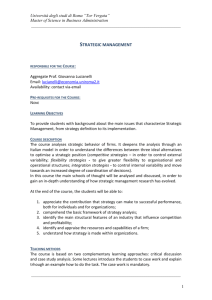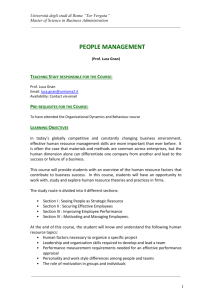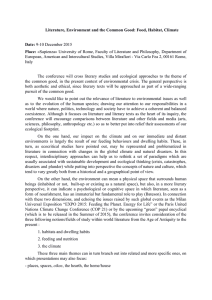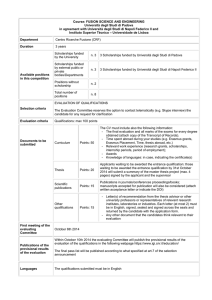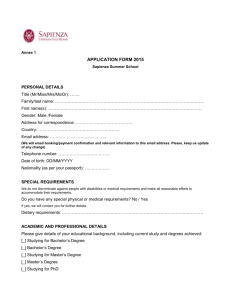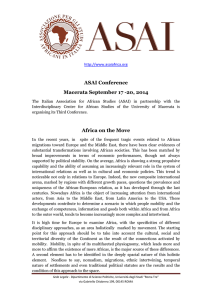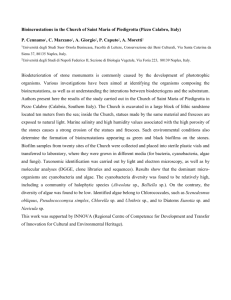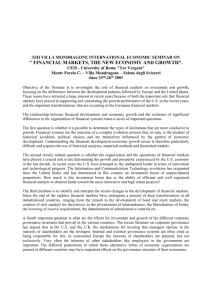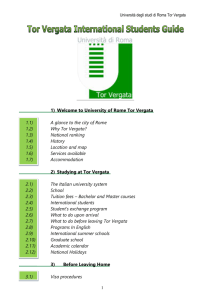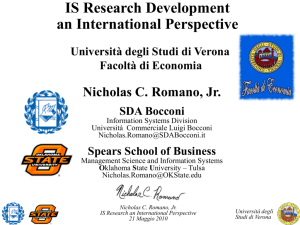family business - Economia - Università degli Studi di Roma Tor
advertisement
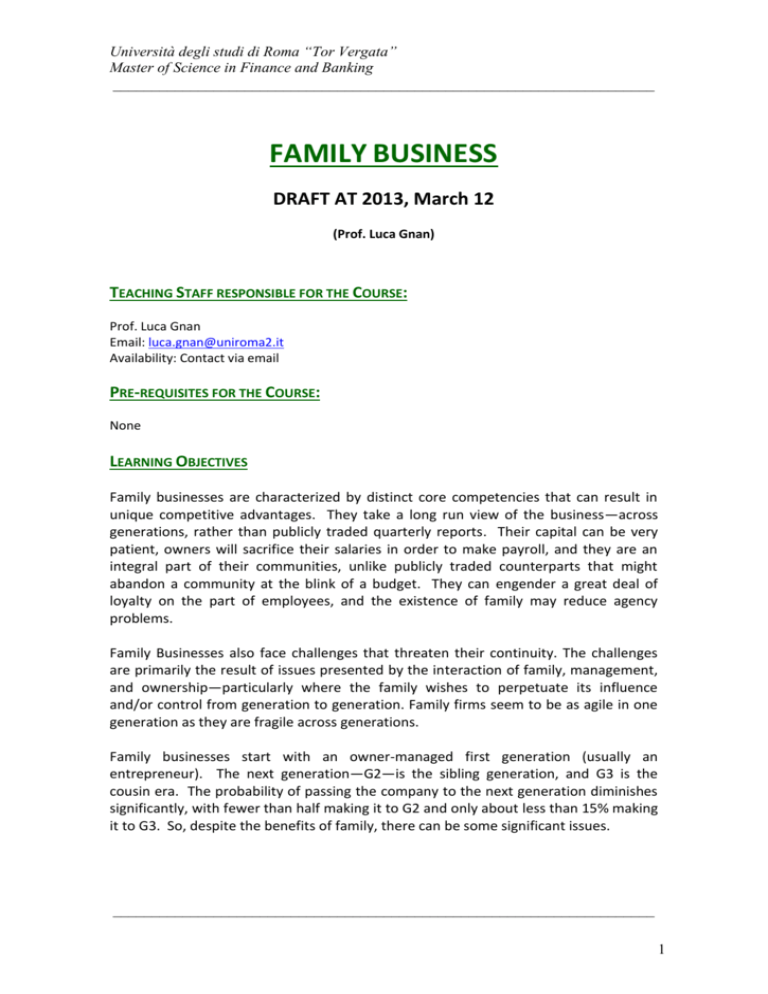
Università degli studi di Roma “Tor Vergata” Master of Science in Finance and Banking ______________________________________________________________________ FAMILY BUSINESS DRAFT AT 2013, March 12 (Prof. Luca Gnan) TEACHING STAFF RESPONSIBLE FOR THE COURSE: Prof. Luca Gnan Email: luca.gnan@uniroma2.it Availability: Contact via email PRE-REQUISITES FOR THE COURSE: None LEARNING OBJECTIVES Family businesses are characterized by distinct core competencies that can result in unique competitive advantages. They take a long run view of the business—across generations, rather than publicly traded quarterly reports. Their capital can be very patient, owners will sacrifice their salaries in order to make payroll, and they are an integral part of their communities, unlike publicly traded counterparts that might abandon a community at the blink of a budget. They can engender a great deal of loyalty on the part of employees, and the existence of family may reduce agency problems. Family Businesses also face challenges that threaten their continuity. The challenges are primarily the result of issues presented by the interaction of family, management, and ownership—particularly where the family wishes to perpetuate its influence and/or control from generation to generation. Family firms seem to be as agile in one generation as they are fragile across generations. Family businesses start with an owner-managed first generation (usually an entrepreneur). The next generation—G2—is the sibling generation, and G3 is the cousin era. The probability of passing the company to the next generation diminishes significantly, with fewer than half making it to G2 and only about less than 15% making it to G3. So, despite the benefits of family, there can be some significant issues. ______________________________________________________________________ 1 Università degli studi di Roma “Tor Vergata” Master of Science in Finance and Banking ______________________________________________________________________ The course explores and analyzes family business continuity challenges and best management practices. The focus of this course is on pragmatic, action-oriented, management, governance, finance, and family/business leadership skills. Attention is devoted to evaluating family firms and its growth options to provide a roadmap for analyzing how family ownership, control, and management affect performances and how more value can be created and ensured through generations. The course is divided into 3 different sections: Section I: original features, peculiarities and governance of family firms Section II: managerial dynamics and family firms’ financial evaluation Section III: family office services The course addresses the governance and the finance of established family businesses. It examines succession, values, life cycles, marketing strategies, conflict resolution, communications, legal, and financial aspects, estate planning, management, philanthropy and other topics that uniquely touch family business governance and finance. It will convey the characteristics that differentiate family businesses from other businesses. Upon completion of this course, students should understand: 1. the unique assets and vulnerabilities of family enterprises. 2. the role of the CEO in governance, management, and the transfer of power 3. the relationship between the role of the board, the family council, and top management in providing effective governance for family business continuity 4. key family dynamics and be able to: 1. Identify the various stakeholders and the role of trust among family members and their impact on succession and continuity 2. Discuss the developmental needs and challenges of next generation leaders 3. Analyze the effect of estate taxes on ownership transfer across generations of family business owners and the implications of ownership structures on the competitive advantages of family businesses 4. Explain the importance of strategic planning to family business continuity 5. Explore the critical role and challenges that non-family managers play in familyowned operations 6. Analyze the impact of family culture, family communication, family conflict, and family unity and explore their interaction effects on the family business ______________________________________________________________________ 2 Università degli studi di Roma “Tor Vergata” Master of Science in Finance and Banking ______________________________________________________________________ TEACHING METHODS The adopted teaching method is a Participant-Centered Learning one, that is highly interactive. Each module maybe composed of a frontal lesson, which is a theoretical foundation brick, immediately followed by class open discussion of one or more real cases, and a full debrief with key take-away points. Additional tools will be profitably used, such as role-playing, testimonials, etc. MAIN REFERENCES - - - Poza, E. J. Family Business, First Edition. Mason, OH: Thomson South-Western, 2004. L. Gnan, D. Montemerlo, (2006) “Family-firm relationship in Italian SMEs: ownership and governance issues in a double-fold theoretical perspective”, in P. Z. Poutziouris, K. X. Smyrnios e S. B. Klein, Handbook of research on family business, Edward Elgar Publishing. de Pedys V., Antonelli A. “ Family office for family business” Oxford management Publishing, 2008, ISBN 978-1-906728-01-4, (available at the following link http://www.oxmp.co.uk/item_det.php?id=94 ) P. Poutziouris, (2001) ‘Understanding family firms’, in (Ed) Adam Jolly, Institute of Directors-The Growing Business Handbook, London: Kogan Page Chapter 6.3; pp. th - 9-15 , 4 edition, ISBN 07494 3600 X. R. Levin, V. Travis “Small company finance: what the books don’t say” in Harvard Business Review no. 87608, nov-dec 1987. Villalonga B. and Amit R. (2005) “How do family ownership, control and management affect firm value”, Journal of financial economics 80 (2006), 385-417 (available on line at www.sciencedirect.com and www.elsevier.com/locate/jfec As far as the textbooks are concerned , students will need to prepare the following sections: - Poza, E. J. Family Business, Second Edition. Mason, OH: Thomson South-Western, 2006 : Chapter 8 pp. 137-152 (Family Business Governance) Chapter 9 pp. 153-167 (Family Culture) Chapter 11 pp. 271-290 (Family meetings, councils and family offices) - L. Gnan, D. Montemerlo (2006): all - P.Poutziouris (2001) : all - B. Villalonga, R. Amit (2005) : sections 1,2,3,5 - R. Levin, V. Travis (1987) : all During the course, 9 cases will be discussed: (the following 2 cases from the textbook Poza, E. J. Family Business, Second Edition. Mason, OH: Thomson South-Western, 2006 and other sources): ______________________________________________________________________ 3 Università degli studi di Roma “Tor Vergata” Master of Science in Finance and Banking ______________________________________________________________________ 1. The Vega Food Company 2. The Grupo Ferrè Rangel (the following 6 cases from Harvard Business School Publishing. You need to register to download the cases at the following link: https://hbr.org/registration?conversationld=1011637, then download each individual case at the indicated link) 3. “R & R” : http://hbr.org/product/r-r/an386019-PDF-ENG?Ntt=mossi 4. “Anderson Steel service inc” : http://hbr.org/product/anderson-steel-serviceinc/an/899011-PDF-ENG?Ntt=davis%2520%2520anderson 5. “Matthew A. Hunter” : http://hbr.org/product/matthew-a-hunter/an/806203-PDFENG?Ntt=davis%2520%2520malhotra 6. “Khalil Abdo Group”: http://hbr.org/product/khalil-abdo-group/an/898011-PDFENG?Ntt=kholil 7. “Butler Lumber company” : http://hbr.org/product/butler-lumber-co/an/292013PDF-ENG?Ntt=butler%2520lumber 8. “Pitcairn family Heritage fund”: http://hbr.org/product/pitcairn-family-heritage-rfund/an/208073-PDF-ENG?Ntt=villalonga&Nao=10 and 9. “Kff or the taramosalada kings” in “The growing business handbook” (cited above) chapter 6.1, pp 107-112; or in P. Poutziouris , D. Pistrui (editors) “Family business research in the 3rd millennium:building bridges between theory and practice” FFI publications, Oct 2001 CASE DISCUSSIONS Students are expected to be fully engaged in the entire learning process. This means that students need to prepare the assigned readings of the cases prior to each class and come to class prepared to participate in group work and/or discussions to enhance the learning of the individual and the class. Students will find the relative assignment for each case on the website. Please read the questions carefully before the lesson. The objective is to involve all the class members in the discussion. The cases are designed to integrate the concepts from the case into the context of the course. With case discussions, each student will develop: 1. The ability to set the parameters for the problem (key concepts from the case). 2. Ample knowledge regarding the subject of the case (understanding of material, good response to the observations of others). 3. The ability to connect the case to other course concepts. 4. The ability to involve others in the discussion. ______________________________________________________________________ 4 Università degli studi di Roma “Tor Vergata” Master of Science in Finance and Banking ______________________________________________________________________ In order to effectively discuss the cases, students need to be: prepared with facts and specific quotes from the case. prepared to comment, ask questions, or make observations about the case. During the discussion, students need to: take a position on a question or a point. ask questions to clarify a point. help keep the discussion moving and on track. help draw others into the discussion. integrate theories and content from other cases. During the discussion, students should not: come unprepared and show your lack of knowledge. monopolizes the discussion. make irrelevant comments. be insensitive to other’s desire to speak or share opinions. OTHER LEARNING SOURCES Slides and other material will be available on the course website. ATTENDANCE Because of the concentrated nature of the MScBA programme, attendance in class is very important. Students who miss more than 6 hours (including arriving late or leaving early) will be required to prepare ALL the chapters of the textbooks and other materials for the exam. NOTE: Attendance for the first class session is mandatory as important information regarding the course and the instructors’ expectations are given. If you know in advance that you will be absent for one session, please contact your instructor to ensure that absence from a particular session is acceptable. EXAM The exam is made up of two parts: a written and an oral exam which will be held on the same day. I° - Written exam) You may be given questions to answer regarding a case study. As you respond to the questions, please use specific content and theories (use names to identify theories and models) as the basis of your analysis. You will not receive credit for your personal opinions unless backed by theory, lecture, and/or text material. ______________________________________________________________________ 5 Università degli studi di Roma “Tor Vergata” Master of Science in Finance and Banking ______________________________________________________________________ Moreover, describe how the content/theory can be applied to the situation. Your answers will be evaluated on both quantity and quality. Answers that are more detailed and demonstrate a higher level of understanding and analysis will receive more points. II° - Oral exam) You may be asked to discuss your written answers to the case questions and to focus on some specific theoretical issues. ______________________________________________________________________ 6
